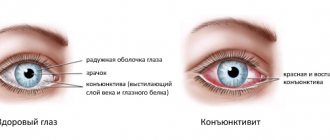Diagnosis of conjunctivitis in children and adults
Treatment is based on the causes of inflammation, and they can be very different: from viral infection to allergic reactions. Therefore, you cannot do without professional diagnostics.
In this article
- Diagnosis of conjunctivitis in children and adults
- What to do for conjunctivitis: first aid for the patient
- Treatment of bacterial conjunctivitis
- How can viral conjunctivitis be treated?
- Conjunctivitis: treatment with physiotherapy
- Quick treatment of conjunctivitis using traditional medicine
To understand how to treat conjunctivitis in an adult or child, you need to determine its shape and type. Only an ophthalmologist can make a diagnosis. To identify the cause of its development, a specialist conducts a survey about diseases, working conditions and probable contacts with a carrier of a viral disease.
A study of discharge from the eye is also carried out: this method allows you to determine the causative agent of the disease. Sometimes additional consultations are carried out with other doctors, for example, an allergist.
If conjunctivitis is mild, it can be cured fairly quickly, and the danger is not the disease itself, but the possibility of its spread. Following the rules of hygiene will help reduce the risk of the disease spreading to the healthy eye and other people. Among them:
- using your own towels and pillowcases;
- regular hand hygiene;
- avoiding contact with other people and visiting public places;
- avoiding contact of chlorinated water with eyes.
Prevention of non-bacterial eye inflammation
Conjunctivitis without pus is no less dangerous than infectious inflammation. It is easier to avoid a disease than to fight it. In adults, eye inflammation occurs less frequently than in children. In a child, non-purulent conjunctivitis is usually of an allergic nature.
Basic hygiene rules will help your eyes always stay healthy:
- Do not touch your face with dirty hands;
- During the flu season, hands should be washed with soap more often;
- Wearing someone else's contact lenses is not allowed;
- You should only use personal hygiene items.
People working in dusty areas or with chemicals or medications should use special protective masks.
What to do for conjunctivitis: first aid for the patient
Please note these requirements:
- Use a 20% solution of albucid or 0.3% solution of chloramphenicol. The products must be instilled behind the lower eyelid, 1-2 drops. It is recommended to repeat the procedure every 3 hours. For preventive purposes, you can also instill drops into a healthy eye, but to avoid infection, it is better to do this with a healthy pipette.
- Avoid exposure to bright light; if present, it is recommended to wear sunglasses.
- There is no need to put a blindfold on your eyes.
Conjunctivitis is an inflammation of the mucous membrane of the eye. Irritation causes blood vessels to dilate, causing the eye to turn red. The causes of the development of the disease depend on its form: it can be an allergic reaction, or a consequence of a viral or bacterial infection. In any case, it is accompanied by unpleasant symptoms, and therefore it should be cured as soon as possible.
Symptoms
Common symptoms include the following:
- Pain and discomfort in the eye (burning, itching).
- Increased sensitivity to bright light.
- Copious fluid secretion (especially in the first days).
- The appearance of small ulcers on the cornea of the eye.
- Inversion or adhesions of the eyelids.
- Swelling of the mucous membrane and nearby tissues.
- Blepharospasm (closing of the eyelids).
Note! If you have severe symptoms, you should consult an ophthalmologist as soon as possible and begin appropriate treatment.
Determining the cause of conjunctivitis
To know how to quickly cure conjunctivitis, it is important to correctly determine its nature. Symptoms of the disease differ depending on the causes of its occurrence:
- Viral conjunctivitis can occur in one or both eyes at once. The patient suffers from photosensitivity. This form of the disease is extremely dangerous because it quickly spreads to healthy people and is difficult to treat. The main efforts should be aimed at preventing its complications.
- Bacterial conjunctivitis: It is accompanied by purulent or mucous discharge that accumulates in the corner of the eye. Like the previous type of conjunctivitis, bacterial can affect one or both eyes and is contagious.
- Allergic conjunctivitis: accompanied by other symptoms of an allergic reaction, such as nasal congestion. The disease develops in both eyes, is not transmitted to other people and responds well to treatment.
What to do with conjunctivitis occurring in each of these forms will be discussed later in this article.
Treatment of bacterial conjunctivitis
Conjunctivitis will not be so difficult to cure with the right approach. Most often, bacterial conjunctivitis occurs in children, since they usually neglect hygiene and touch their eyes with dirty hands. If a woman has a bacterial infection, the disease can also affect her newborn baby. Bacteria located on the surface of the skin easily move to the mucous membrane of the eye, which causes the development of the disease. A doctor will quickly help you identify the disease and get rid of conjunctivitis, so when the first symptoms appear, you should seek his help.
How to get rid of conjunctivitis? The first measure in the rapid treatment of bacterial conjunctivitis is the use of antibacterial drops that eliminate pathogenic microorganisms. Among the most commonly prescribed antibacterial agents:
- "Floxal";
- "Tobrex";
- "Oftadek";
- "Albucid";
- "Tsipromed", etc.
For conjunctivitis during pregnancy, antibiotics are selected individually, taking into account the characteristics of the course of pregnancy. Before carrying out the procedures, you need to wash the eyes, since the lacrimal glands do not always cope with this task on their own. Sometimes there is so much purulent discharge that it sticks together the eyes. This usually occurs during the acute stage of development of conjunctivitis. An infusion of chamomile and a solution of furatsilin are suitable for rinsing.
If drops for conjunctivitis do not help and the acute course of the disease drags on, you need to treat it with ointments. They are placed behind the eyelid, after which the patient should close his eyes and make rotational movements. Most often, tetracycline ointment is used for these purposes, which effectively affects pathogenic microorganisms.
The course of treatment is quite long - up to 14 days. This is due to the complexity of treating purulent conjunctivitis and frequent relapses. You cannot make a decision on stopping treatment on your own, since untreated conjunctivitis can arise with renewed vigor.
Forms of the disease
Doctors distinguish 2 forms of catarrhal conjunctivitis, and both of them have their own characteristic signs:
- Acute form - the symptoms are pronounced, there is redness and swelling of the eyelids, purulent discharge, protrusion of the conjunctiva, pain, lacrimation, intolerance to bright light, sensation of a foreign object in the eye.
- Chronic form - the course of the disease is sluggish, it is mainly expressed in redness and dryness of the mucous membrane, the presence of thick serous discharge, and a feeling of discomfort. In some cases, a wave-like course of pathology is observed - a change in exacerbations and remissions.
Important! Acute catarrhal conjunctivitis differs from chronic conjunctivitis in that it develops suddenly with a gradual increase in symptoms.
How can viral conjunctivitis be treated?
A disease such as conjunctivitis can occur in adults and children. It is most often infected in autumn and winter, when human immunity decreases. The main means of combating the disease in this form are interferon drops and antiviral drugs in tablet form. If eye damage in an adult patient is caused by the herpes virus, Ophthalmoferon, Tebrofen, Laferon and other drugs are prescribed. The greatest danger with viral conjunctivitis is dry eye syndrome. The lacrimal glands stop producing secretions that moisten the mucous membrane. As a result, any movement of the eyelid leads to severe irritation. To relieve unpleasant symptoms, it is recommended to use artificial tears.
When the acute course of the disease has stopped, it is worth intensifying treatment with immunostimulating drugs. They will help get rid of sluggish conjunctivitis and will be an excellent preventive measure.
Conjunctivitis: treatment with physiotherapy
In the most advanced cases, it is not possible to quickly cure conjunctivitis, and the specialist prescribes complex treatment, including physiotherapeutic techniques. The purpose of these measures is to stop the suppurative process and eliminate unpleasant symptoms in the form of itching and reactions to external stimuli.
One of the most effective methods for curing advanced conjunctivitis is electrophoresis with antibacterial drugs. To carry it out, Penicillin and Ceftriaxone are most often used. They help extinguish the active inflammatory process. If severe itching occurs, then lidocaine with dimexide is added to the medications. The procedure takes 15 minutes and is carried out daily for 21 days. To suppress the allergic reaction, ultraphonophoresis with dexamethasone is performed. This helps get rid of edema and reduce capillary permeability. The duration of the procedure is up to 8 minutes, a total of 10 procedures are performed.
Which doctor should I contact?
Expert opinion
Ermolaeva Tatyana Borisovna
Ophthalmologist of the highest category, Candidate of Medical Sciences
If the inflammation does not go away within 3 days, you should immediately consult a doctor.
The initial examination is carried out by an ophthalmologist. According to indications, for additional examination and clarification of the diagnosis, the patient is referred to specialized specialists (urologist, gynecologist, allergist).
Viral infection of the conjunctiva is considered a general disease; you should contact a therapist who will prescribe complex therapy.
Quick treatment of conjunctivitis using traditional medicine
To get rid of conjunctivitis, you can use not only pharmaceutical drugs, but also folk remedies. They have an equally strong effect, but they should only be used in conjunction with medications. The most effective:
- Chamomile infusion has a gentle effect on the eyes, but at the same time perfectly relieves the inflammatory process. To prepare it, you need to take a spoonful of the dry plant and pour a glass of boiling water. The product must be infused for several hours. Chamomile infusion is used for rinsing and as a lotion on the eyes, which is done for 15-20 minutes up to 5 times a day.
- You can also use regular tea. This remedy is even used to treat a newborn child. It is necessary to brew tea, moisten a cotton pad in it and apply it to the inflamed eyes, removing mucous and purulent discharge from them.
- Dill juice therapy - this remedy has a specific smell. To prepare it, you need to take a bunch of dill, chop it and squeeze out the juice. Soak a cotton pad in the liquid and apply it to the eyes for 15 minutes.
- Dill seeds, horsetail, chicory and marshmallow root are taken in equal quantities and mixed. A tablespoon of the mixture is poured into a glass of boiling water. After the infusion has cooled, a disc is moistened in it and applied to the eyes. Before this, instill a few drops of the product.
- Pour two teaspoons of ground rose hips into a glass of water, bring to a boil and remove from heat. When the broth has cooled, rub your eyes with it. Repeat the procedure up to 4 times a day.
It is worth noting that the use of each remedy should be coordinated with your doctor. Conjunctivitis is a complex ophthalmological disease that, without proper and timely treatment, can lead to serious complications. These include complete loss of vision and soft tissue necrosis. After getting rid of the disease, you should remember about preventive measures and do not forget to apply them.










